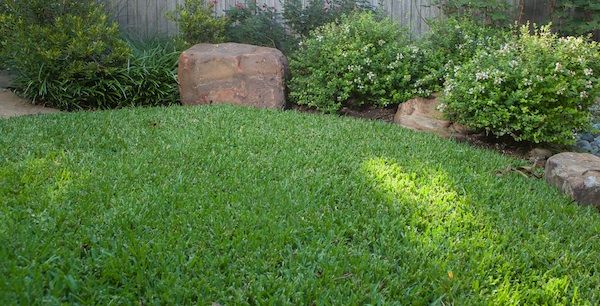Fall back on lawn watering: Brown Patch Disease
October 14, 2014 | By webadmin
In fall when rainfall becomes more common and night time temperatures cool, that’s your signal to start cutting back on lawn watering. With temperatures cooling, plants won’t require as much supplemental water, plus fall rain will help do the job for you. Fall and winter are the times to save resources and let nature do its job! Despite the change in weather, we’re not seeing most homeowners cut back on their sprinkler schedule, resulting in laws being overwatered. Overwatering in this kind of weather is like putting out a big “Welcome” sign for fungal diseases such as Brown Patch.

A healthy lawn is properly watered, fertilized & aerated.
What does Brown Patch look like?
In St. Augustine lawns you’ll notice circular patches that are brown, yellow or tan in color. The patches can run from six-inches in diameter up to a few feet. In shorter-cut lawns, such as Bermuda grass, the patches tend to be orange or brown. In both types of grass the leaf blades affected by Brown Patch will have tan lesions (spots) with a dark brown border.
How can you avoid developing Brown Patch?
The simple answer is to back on watering levels in your lawn in fall and winter. If you’ve been watering in the evening, be sure to switch to an early morning watering schedule. Water that sits on your lawn’s foliage overnight is a breeding ground for fungus. Lawns still need some supplemental water in fall and winter, but not nearly as much as they need in summer. Properly fertilizing your lawn at the right time will help to develop strong roots and and overall plant health, which means less damage from disease.
Lawns that are fertilized with too much Nitrogen are also more susceptible to fungal diseases; because Nitrogen promotes quick green top growth that is more susceptible to the disease. Aerating the soil in your lawn to improve aeration and drainage is another way to reduce your chances of Brown Patch. Lawns with healthy, well amended soil are less likely to become infected. Major infections of Brown Patch are typically treated with fungicides, of which there are organic and conventional options.
Proper maintenance, watering, mowing and fertilizing year-round all aid in keeping grass and soil healthy, which is the best way to avoid most fungal diseases. Looking for an organic maintenance plan to suit your landscape and lifestyle? We have a few options we can discuss to begin this fall in preparation for winter. Contact info here.
